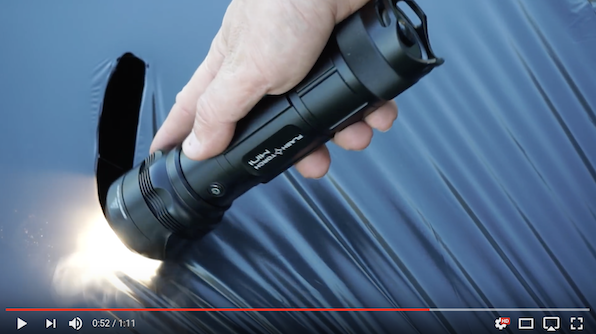Home
A comprehensive resource for safe and responsible laser use
US: FAA warns against aiming holiday lasers into the sky
With the holiday season upon us, the Federal Aviation Administration (FAA) wants to make sure your laser-light displays are aimed at your house and not into the sky.
Each year we receive reports from pilots who are distracted or temporarily blinded by residential laser-light displays. You might not realize this, but a well-meaning attempt to spread holiday cheer has the potential to create a serious safety risk to pilots and their passengers flying overhead.
So please make sure all laser lights are directed at your house and not into the sky. The extremely concentrated beams of laser lights reach much farther than you might realize.
If we become aware that your laser-light display affects pilots, we’ll ask you to adjust them or turn them off. If your laser-light display continues to affect pilots, despite our warnings, you could face a civil penalty.
Laser strikes against aircraft continue to increase each year. Last year we received 6,754 reports of laser strikes against aircraft, a 250 percent increase since we started tracking laser strikes in 2010.
Intentionally aiming a laser at an aircraft is a serious safety risk and violates federal law. Many high-powered lasers can completely incapacitate pilots who are trying to fly safely to their destinations and may be carrying hundreds of passengers.
We work with federal, state, and local law enforcement agencies to pursue civil and criminal penalties against individuals who purposely aim a laser at an aircraft. We may impose civil penalties of up to $11,000 per violation. Civil penalties of up to $30,800 have been imposed by the FAA against individuals for multiple laser incidents.
US: 2 Watt "laser bongs" for sale
The laser beam is so intense it is a diffuse reflection hazard. The bong comes with 2 pairs of protective eyewear.
![]()
The founder of the company said in a November 2018 email to Mashable that the laser is not dangerous but can sting if you get your hand in it "kind of like a magnifying glass."
In addition to the 445 nm blue laser and protective glasses, the app-controlled bong also has a rotating bowl and color-changing LEDs.
The product has been in the works for some time. According to Gizmodo, a January 11 2018 Instagram video from Silicon Cali's founder demonstrated a prototype laser bong available for pre-order. On January 23 2018, he wrote on Instagram about shipping time: "It’s just dealing with the FDA regulation and all the other requirements for manufacturing and selling a high powered class4 laser product in the USA that take the time."
It is not known when the late fall 2018 version officially went on sale.
At the company's website, as of November 5 2018 there is no mention of FDA certification nor any picture of FDA-required warning labels, though there is a description of "turn key ignition." In the photo above, a small key can be seen inserted into the bottom of the bong. Federal law requires a key or similar lock-out device to prevent laser devices from being turned on by unauthorized users.
Laser bongs are a relatively old idea among persons interested in high tech and recreational drugs. A web search turns up a July 30 2009 post to Grasscity Forums, linking to a YouTube video of a prototype LaserBong (different product) made by the chief engineer of Wicked Lasers. The video is now unavailable at YouTube. Other YouTube videos still online show, for example, a June 4 2013 video of a person using a handheld blue laser to ignite bong material.
From Silicon Cali with additional reporting by Mashable and Gizmodo.
UK: BAE Systems can filter 3 laser wavelengths with 70% normal transmission
According to an October 31 2018 story about BAE's anti-laser efforts, "Bray says a lot of work has gone in to developing products that protect pilots from this form of attack; now much of the challenge is about developing the frames to house the filters."
The story also discussed the number of reported laser incidents in the U.S. and U.K. in recent years, concerns about laser use against military aircraft in the East China Sea and East Africa, and Chinese development of dazzling and blinding laser weapons.
It concludes with Bray's discussion of challenges for laser eye protection: "Among them are achieving performance for off axis incidence of laser, a high absorption at the wavelength of interest whilst keeping the transmission high elsewhere, and ensuing they work, something not easily done given the risk to individuals if they don’t work.”
From Air Force Technology
Canada: Satair, Metamaterials sign anti-laser glare protection distribution deal
Customers will include commercial and military pilots, both fixed-wing and rotary, in markets including commercial aviation, business aviation, search and rescue, police, medevac and military.
Satair is a part of the Airbus Customer Services unit. In 2014 Airbus brought Nova Scotia-based MTI into an innovation start-up program, working to commercialize aircraft windscreen film to protect pilots from laser glare and flashblindness. In June 2017 Satair and MTI signed a memorandum of understanding focused on the civil aviation market.
According to MTI, "Detailed market research and discussions with potential customers since then has confirmed that the overwhelming preference is for this innovative new product to be introduced to the market through individual eyewear and visor products which incorporate MTI’s laser glare protection technology."
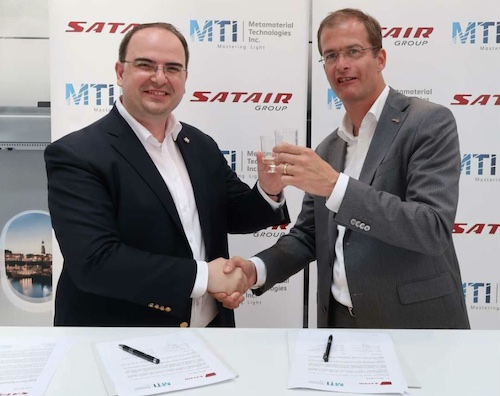
MTI's George Palikaras, founder and CEO (l), and Satair CEO Bart Reijnen (r) sign a distribution agreement at the October 2018 MRO Europe trade show for maintenance, repair and overhaul operations.
The October 2018 agreement widens the market and covers "eyewear and visor products that are developed or manufactured by MTI. These include, without limitation, all sub-components, sub-assemblies, piece parts, software and hardware."
MTI says their technology "is superior to other products currently on the market due to a unique and patented dielectric (non-metallic) optical metamaterial filter, which has been scientifically engineered to ensure that the pilots’ vision and interpretation of the surrounding environment is not disturbed during critical phases of flight."
From an October 17 2018 Metamaterial Technologies Inc. press release
UPDATED: In a February 19 2019 press release, Satair's customer solutions director says initial product applications will appear in the first quarter of 2019. He also said "The technology is highly scalable so it can be customised for a wide variety of platforms and other applications. In commercial aviation the green laser poses the biggest threat because the human eye is more susceptible to the green wavelength. For military markets the red laser may be the largest threat. The advantage of the MTI product compared to other products in the market is that it can be customised to the wavelengths the customer wants to be protected against. As we have exclusive distribution rights across civil aviation, military and defence, we are open to do business with leading OEMs of products such as night vision goggles, head-up displays, helicopter and fighter pilot helmets and aircraft flight deck visors. Other products in the market do not have the same quality, the same level of protection and colour balance that we have.
Thanks to Peter Smith and Leon McLin for bringing the February 2019 press release to our attention.
US: DoD awards nearly $250 million in contracts for pilot laser eye protection
The contracts went to Gentex and to Teledyne Scientific & Imaging, and will be completed by September 2024.
Earlier, on August 10 2018, DoD announced a $49 million contract for the Flash and Laser Airborne Protection System, which provides for research, development and manufacturing of photonic resistant material to protect air crews from flash blindness. Photonic shielding is used on high-value military aircraft such as Air Force One, but is not in widespread use.
The contract went to UES Inc. of Dayton Ohio, and will be completed by November 2024.
According to an October 1 UPI story, "the Pentagon started moving on improved eye protection for pilots after the Chinese military reportedly used lasers against pilots from a base in Djibouti, as well as in the South China Sea."
From UPI (Oct 1 story about Gentex and Teledyne) and UPI (Aug 13 story about UES)
Germany: Laser/aircraft incidents decline 12.4% compared to last year
This decrease is despite a doubling of incidents at Frankfurt International Airport. In the first half of 2018 there were 22 laser illuminations versus only 11 during the same period in 2017.
Declines were reported at Munich, Hamburg and Stuttgart airports.
A spokesperson for the German pilots' union Vereinigung Cockpit seemed to indicate that increasing prosecutions were a cause of the drop from 2017 to 2018: "A few years ago, the laser attack was a hip prank for some young people. The perpetrators must now be aware that they are consistently prosecuted."
From DW.com reporting on a story from public broadcast service ARD. Thanks to Greg Makhov for bringing this to our attention.
New Zealand: Bill proposes to double jail term, fines for laser illuminations of aircraft
For possession of a high power laser, the maximum fine would be doubled to NZD $4000, and the maximum prison time would be doubled to six months.
Penalties would also be increased for selling laser pointers.
The president of the New Zealand Airline Pilots Association (NZALPA) supported the bill, saying "This is a constant source of frustration for ourselves and law enforcement agencies."
From Stuff.co.nz. As of September 8 2018, the text of the bill was not available on the bill's page at the New Zealand Parliament website.
UK: Home Secretary wants more power for police to search for laser pointers
Javid will open a public consultation to extend the power of "reasonable grounds" (to search suspects). Proposed changes will go before Parliament.
From September 4 2018 articles in The Times and The Sun
Switzerland: Class 1 limit (0.39 mW) on sale, possession of laser pointers is proposed
According to FOPH, “An increasing number of laser pointers has been placed on the market that pose a danger to human health and to pilots or locomotive drivers. In order to avoid both dangerous glare and direct eye damage in the future, only class 1 lasers pointers will be allowed to be placed on the market.”
Comments are requested by October 5 2018. The proposed date of adoption is March 1 2019, and the proposed date of entry into force is January 1 2020.
The O-NIRSA draft ordinance is available in German, French and Italian. The current Federal Act on Protection Against Hazards Arising from Non-Ionising Radiation and Sound (NIRSA) is available in German, French (no link), Italian (no link) and English.
We were not able to find a link for the submission of comments; you may want to check with the Swiss Federal Office of Public Health (FOPH) and/or the Swiss Association for Standardization (SNV).
From an item in the August 2018 ESTA Standards Watch
Commentary from LaserPointerSafety.com: If adopted, a Class 1 limit would be the strictest in the world. There are many countries that have a Class 2 (1 milliwatt) limit on laser pointers, and some that have a slightly higher Class 3R limit (5 milliwatts).
For red laser pointers, Class 1 would make them barely visible under normal classroom or presentation scenarios. Because green light appears brighter to the human eye, a Class 1 laser pointer may be acceptable. However, LaserPointerSafety.com has never seen a Class 1 laser pointer.
South Korea: Firefighter suggests how laser pointers can help in fighting fires
The net-like grid will make the surface contour visible.
eBay Korea hosts a contest for firefighters to find and then develop useful firefighting tools. Bethel also has submitted ideas for laser-projecting messages from the back of fire trucks onto streets. He said, “The laser pointers will display signs, such as ‘no entry’ or ‘this lane is occupied by a fire engine’. By doing so, it can help firefighters save time spent setting up a perimeter using traffic cones.”
From a July 16 2018 story in the Korea Times
China: "Laser AK-47" assault rifle said to be manufactured; experts skeptical
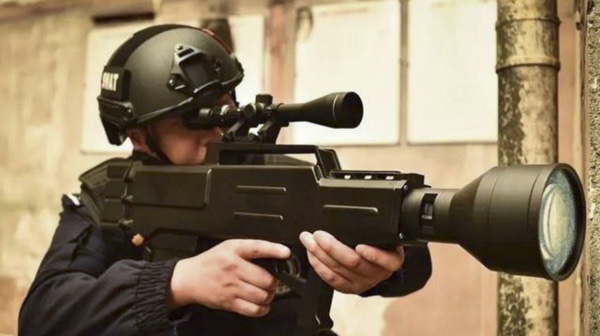
The July 1 2018 report appeared the In South China Morning Post. It quoted a “researcher who had [taken] part in the development and field testing of a prototype at the Xian Institute of Optics and Precision Mechanics at the Chinese Academy of Sciences in Shaanxi province. The source said “The pain will be beyond endurance.” Another researcher said that because the beam is invisible and noiseless, “nobody will know where the attack came from. It will look like an accident.”
A technical document stressed the “non-lethal” nature of the laser rifle, listing attacks such as burning the banners or clothing of “illegal protests”.
The laser capability claims were disputed, however, by numerous news outlets.
TechCrunch writer Devin Coldewey first noted that military laser systems capable of delivering damaging heat over hundreds of meters require “on the order of tens of kilowatts, and those have trouble causing serious damage.” He calculated that a Tesla Powerwall using lithium ion batteries produces a few kilowatts of power and weighs over 200 pounds. (The complete laser rifle weighs 6.6 pounds.) Coldewey said the problem was atmospheric attenuation of the laser beam which is “non-trivial at anything beyond, say, a few dozen meters. By the time you get out to 800 [meters, the laser’s claimed range] the air and water the beam has traveled through [are] enough to reduce it [to] a fraction of its original power.”
Canada: Restrictions on high-powered handheld lasers in three cities
Persons are banned from possessing such lasers outside of their home, without a legitimate purpose such as work, school, education or astronomy.
Police can question anyone with a laser in one of the prohibited zones if they had a reasonable reason to search them. Examples given included if a member of the public contacted police with a specific description of a person they saw holding a laser, or if police themselves saw the person holding a laser.
Any person with a battery-operated, handheld laser in a prohibited zone 1) outside of a private dwelling and 2) without a legitimate purpose could be fined immediately and “on the spot” up to CDN $5,000. A corporation violating the law would be fined up to CDN $25,000. The fines are in addition to any criminal prosecution; intentionally aiming a laser at an aircraft could result in five years in prison and/or up to CDN $100,000 in fines.
According to Transport Canada, “You don’t need to carry any documentation, but you should be prepared to demonstrate to the officer why you’re in possession of a hand-held laser. Law enforcement will be trained to know when and where people may possess a laser. They will exercise their discretion and judgement when determining whether or not to issue a fine.”
Transport Canada has a webpage with details of the laser prohibitions, a question-and-answer page about the new laser safety measure, and an online forum “Let’s Talk - Lasers” seeking feedback on laser safety issues. The “Let’s Talk - Lasers” consultation closes for comments on August 27 2018.
They also have an online interactive map detailing the prohibited zones. Here are two examples of map output:

Laser-prohibited zones in the entire country
Closeup of laser-prohibited zones in the Toronto area
The three metro areas of Montréal, Toronto and Vancouver were included since, according to Transport Canada, “The majority of reported laser attacks have occurred in these regions. Transport Canada will continue to monitor the number and location of reported incidents and may adjust the included municipalities as warranted.”
The agency discussed how the fines were determined, and how law enforcement will decide on the exact fine amount: “These fines, called administrative monetary penalties, come from the Aeronautics Act and the Canadian Aviation Regulations. Law enforcement uses discretion on how much to fine an individual. The amount may depend on previous infractions and circumstances surrounding this infraction.”
When concluding his announcement, Garneau stated “we have the tools that law enforcement agencies need, including Transport Canada inspectors and police forces, in order to put an end to these careless and reckless actions — actions that could have tragic results.”
From the Canadian Press, the CBC, iPolitics, a video of Marc Garneau’s announcement on GlobalNews.ca, and the Transport Canada informational webpage and Q&A webpage.
For much more information and commentary from LaserPointerSafety.com:
Israel: Laser-equipped drones to fight incendiary kites and balloons
From late March to mid-June 2018, 450 fires caused by the aerial attacks burned about 7,500 acres of farmland and national parks, including 1,400 acres of wheat.
In response, the IDF has developed systems to locate the kites and balloons, either intercepting them or sending fire fighters to the landing locations. One interception technique uses a laser on a drone that in tests “has been successful in incinerating the incoming trajectory, neutralizing it and bringing it down.” It is expected to be deployed “soon” according to news stories in late June 2018.
From the JewishPress.com, L.A. Times, and The Times of Israel
US: Indiana medical groups working on resolution about laser pointers
The information was at the end of a story about an Indianapolis boy who injured his eye when playing with a laser pointer five years ago, when he was 12 years old. The story is summarized here.
From RTV6 The Indy Channel
UK: Average of 50 laser illuminations of military aircraft per year in UK
It is not clear if these military incidents are included in the Civil Aviation Authority (CAA) statistics about laser illuminations of aircraft.
The Ministry of Defence figures, made public June 11 2018, were rounded to the nearest 10. The list below shows the reported military-related laser incidents in the UK, along with the CAA numbers for the UK and for overseas UK operators
2013 - 40 military, 1396 CAA UK home, 329 CAA UK overseas operators
2014 - 70 military, 1447 CAA UK home, 317 CAA UK overseas operators
2015 - 70 military, 1440 CAA UK home, 355 CAA UK overseas operators
2016 - 30 military, 1258 CAA UK home, 274 CAA UK overseas operators
2017 - 40 military, 989 CAA UK home, 243 CAA UK overseas operators
The information was released in response to a written parliamentary question submitted by former defence minister Kevan Jones, who said “New laws to deter those stupid enough to carry out these attacks might not be enough, and the Government should give police operating around air bases the resources needed to catch offenders.”
From the Mirror. We have additional statistics and stories about the UK, plus a page with statistics about the UK and other countries.
World: Wicked Lasers sells white-light flashlights (non-laser) capable of burning objects
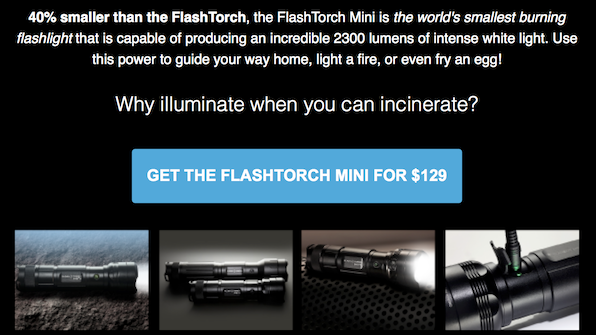
A YouTube video demo shows the flashlight burning a swath of black plastic:
Both the original FlashTorch and the Mini version have a regular price of USD $199.
Wicked Lasers is known for being the first widespread supplier of Class 4 handheld lasers, with a nominal 1 watt blue laser introduced in mid-2010. Since that time, Wicked has taken laser safety actions such as requiring a buyer to take a short safety test before allowing an order, voluntarily putting a label on the laser warning not to aim at aircraft, supplying safety information with the laser, and supporting laser safety efforts.
From a email sent June 7 2018. The FlashTorch webpage is here. Previous LaserPointerSafety.com stories about Wicked Lasers are here.
US: Advisory committee recommends pilot procedures, training and glare protection
ARP6378™ has three main parts:
- A description of how lasers can interfere with pilots’ vision and operational performance, and how pilots can reduce adverse effects.
- A recommendation for pilot training, including exposure to safe, simulated laser light in a simulator or other realistic flying environment
- A description of Laser Glare Protection eyewear and windscreen film, with recommendations for whether and how to use these.
The document was developed by the SAE G10OL “Operational Laser” committee over a two-year period. It is available for purchase from SAE for $78. A three-page preview, which includes most of the Table of Contents except the appendices, is here.
From SAE ARP6378™, “Guidance on Mitigation Strategies Against Laser Illumination Effects”, published June 2 2018. Available from SAE.org.
Click to read more...
US: Marines to buy 1,653 eye-safe laser dazzlers
- An infrared (1535nm) laser rangefinder determines the distance to a person or object. The closer the distance, the lower the laser power output.
- Near-field detection shuts off laser emission if a person or object is too close to the laser output aperture.
- A 3-axis gyroscope detects motion. If the Glare Recoil is suddenly moved, the laser shuts off until stability is resumed and an accurate determination of the distance to a person or object can be re-established: “This prevents hazardous irradiance in situations where Glare Recoil is moving faster than the laser rangefinder can detect objects and dose power output. This results in the prevention of eye hazard danger caused by rapid movement of the device (example: flagging) or improper situational awareness of the operator.”
With these technologies, the laser detects objects or people in the proximity of the beam and then self-adjusts the power output to maintain eye safety. The Nominal Ocular Hazard Distance is said to be 0 meters; the range is 10 feet to 10 miles.
Suggested uses include urban patrolling, cordon and search, crowd control, clearing facilities and security checkpoints.
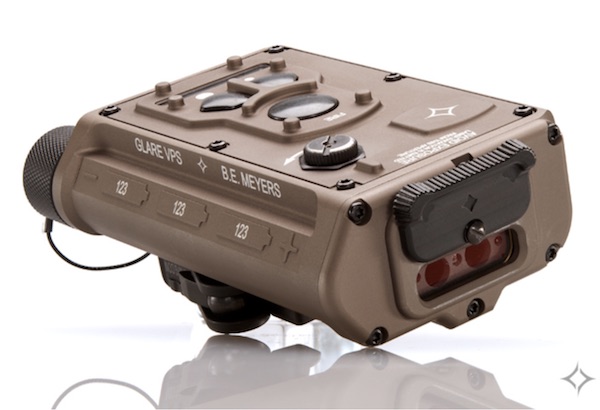
The Glare Recoil is about the size of a Walkman tape player at 5.5” x 3” x 2”. It can mount on a rifle or be handheld.
Meyers also sells a Class 1M “Glare Helios” which has an FDA variance allowing sales to U.S. local, state and federal law enforcement, and U.S. flagged vessels.
From Marine Corps Times, Soldier Systems, and B.E. Meyers. A video produced by the company goes into detail about the specifications and how the person/object detection works.
US: Low-cost malaria detector uses a laser pointer and a magnet
The portable device is about the size of a toaster. It “has been made simple enough to be used by everyone and is also compact and rugged so that it can be shipped worldwide.”
One of the principal researchers is working on making this commercially available.
Popular press account at CrazyEngineers.com. Scientific paper published May 21 2018: Rapid Diagnostic for Point-of-Care Malaria Screening, Samantha E. McBirney, Dongyu Chen, Alexis Scholtz, Hossein Ameri, and Andrea M. Armani, ACS Sensors Article ASAP, DOI: 10.1021/acssensors.8b00269
UK: New UK law provides stronger penalties, easier prosecution for aiming a laser at a vehicle
The penalties for violations are up to five years imprisonment and an unlimited fine; these penalties take effect starting July 10 2018.
The law applies to laser beams aimed at aircraft, motor vehicles, trains, ships, hovercraft and other vehicles. A vehicle does not have to be moving at the time of offense; if the engine or motor is running then the law applies. Another provision makes it an offense to shine or direct a laser beam towards an air traffic facility, or a person providing air traffic services, under the condition where the beam dazzles or distracts, or is likely to dazzle or distract a person providing air traffic services.
The offense is a strict liability offense, meaning that prosecutors do not need to prove that the person shining the laser intended to endanger the vehicle or air traffic facility/controller. There are two defenses allowed: 1) the person had a reasonable excuse for shining the laser beam, or 2) the person did not intend to shine a laser at the vehicle/ATF/controller and exercised all due diligence to avoid doing so.
Click to read more...
US: Air Force wants 38,000 more laser eye protection glasses and visors
While the original draft RFP was published for comments on March 27 2018, the revised request takes on additional urgency after the Pentagon on May 3 2018 accused China of aiming lasers at aircraft flying from a U.S. airbase in Djibouti. According to the Pentagon, two pilots had minor, short-term injuries as a result. The next day, China denied using lasers against aircraft in Dijibouti, calling them “groundless accusations.”
The current provider of the Air Force’s laser protection is Teledyne Scientific & Imaging, which was awarded a $30.1 million contract in July 2016 for 11.805 Aircrew Laser Eye Protection (ALEP) Block 2 glasses. The May 2 2018 RFP is for Block 3 glasses and visors. and will provide protection both during the day and at night from laser light.
The RFP’s Requirements Matrix does not specify the exact wavelengths to be blocked. It does say that the night version must have at least 50% visibility (Photopic Luminous Transmittance) and at least 14% for day versions. The document also states:
The ALEP Block 3 will not impair visual performance to the extent that it interferes with safety of flight or mission completion. The device will be visually compatible with the following devices/activities:
- All USAF aircraft
- Joint Helmet Mounted Cueing System (JHMCS); Night Vision Goggles (NVG); Panoramic Night Vision Goggles (PNVG), Helmet Mounted Integrated Targeting (HMIT/HoBiT), and fielded/post- Milestone B visors and aircrew chemical warfare masks
- Canopies/windscreens, HUD, and color cockpit displays
- Detection, recognition, identification, and tracking of targets
- Ability to distinguish terrain colors and geographical features
- Cockpit interior lighting, external aircraft lights, and airfield lights
- Ability to read charts, maps, and other printed materials in the cockpit
- Ability to perform normal aircraft duties in cockpit
From Jane’s 360 and the Air Force Aircrew Laser Eye Protection Block 3 IDIQ Draft RFP. When navigating the FRP webpage, note that there is the Original Synopsis dated March 27 2018 and the “Changed” version dated May 2 2018. There may be subsequent versions as well. The Statement of Work and the Requirements Matrix are the primary documents in the RFP.
Ukraine: Developing countermeasures after 4 cases of laser eye injury
“We already had several such cases (a laser injury of the eye retina) in the State Border Guard Service and in the National Guard. We are now developing countermeasures. We do not fully understand what they use, but we are already working on the instructions what it could be. We will install the appropriate filters, devices, use appropriate glasses,” Avakov said.
He reported on four cases of the laser injury of border guards and national guardsmen.
“The use of such weapons is a barbarous situation. We will discuss it at the international level,” Avakov emphasized.
From Kyiv Post
Canada: CDN $3M loan to MTI to manufacture laser eye protection glasses
The company’s metaAIR eyewear uses holographic technology to reflect unwanted wavelengths of light while passing others. According to MTI founder and CEO George Palikaras, the clear glasses do not affect vision like current solutions that can be too dark or affect colors.
“What is innovative in our eyewear is that it does not affect the pilot’s vision. So when you put them on you can still see that green is green, blue is blue and red is red,” Palikaras said at a May 4 2018 press conference. In the photo below, Palikaras is wearing the glasses, which reflect some wavelengths but otherwise appear clear to the wearer.
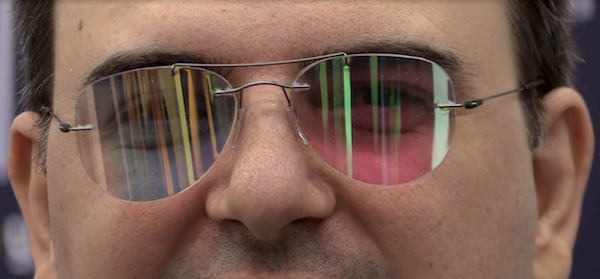
The glasses’ ability to reflect unwanted wavelengths were demonstrated by blocking 99.9% of the green light from a handheld Class 4 (> 500 milliwatts) 532 nanometer laser:
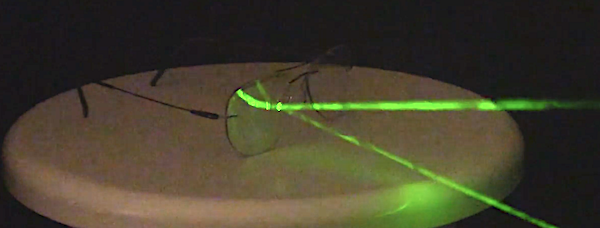
Palikaras said that besides pilots, MTI has had inquiries from the navy and from train operators. He cited incidents involving trains in Germany and Switzerland.
He said the glasses will be sold through MTI’s partner companies and directly to industry buyers.
As of May 2018, MTI has 27 employees, and is looking to hire 15 new full-time employees in production, marketing, research and development. MTI’s holographic technology is also used in developing aircraft windscreens with laser glare protection.
The $3M loan was provided by the Atlantic Canadian Opportunities Agency.
From the Chronicle Herald
Scotland: Scientists develop way to shoot laser light from eyes
The team from the University of St. Andrews demonstrated the new technology by putting a membrane laser onto a standard contact lens (photo a below), then placing this on a cow’s eye (photos b and c). A cow’s eye is similar to human eyes and is widely available as a byproduct of meat processing. The researchers then illuminated the eye with safe pulsed blue light (“Pump” in photo d) and “observed a well-defined green laser beam emerging from the eye” (“Far field emission” in photo d).
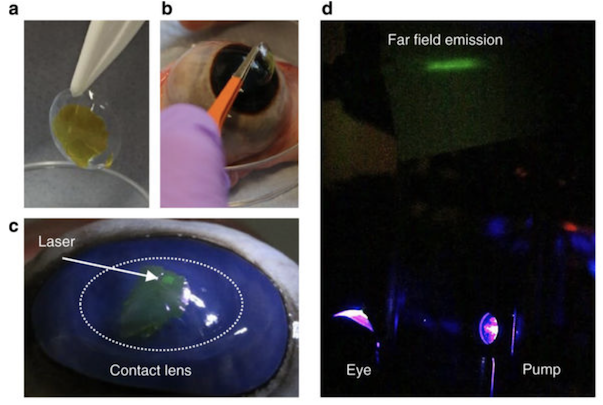
The diagram below shows the narrow wavelength of the emitted light (emission power on the left-hand scale is in “arbitrary units”).

The pump light minimum fluence to cause lasing was 58,800 W/cm², which is about one order of magnitude less than the maximum power density permitted by the ANSI 2000 standard for intentional and repeated ocular exposure. The researchers state that “a membrane laser on a contact lens could thus—under appropriate pumping conditions—be safely operated while being worn in the eye.”
Applications of the membrane laser include use as a security device affixed to banknotes or the human body (researchers also put a laser on a fingernail). A pumping beam is shone onto the substrate (banknote, eye, fingernail) to see if laser light of the expected wavelength is emitted. In the future, “[f]urther optimization of the DFB grating will likely allow lower lasing thresholds and facilitate LED pumping of membrane lasers. By combining recently developed roll-to-roll nanoimprint and organic ink jet printing technology, membrane lasers could be mass-produced with high reproducibility and at low cost.”
The researchers’ paper received widespread publicity, often with photos such as the one below. However, one of the authors, Prof. Malte Gather told the Express, “When we thought about this idea of making the laser membrane, someone suggested it was the first step towards making Superman real. It was meant as a joke but I thought it could be serious after all in certain applications. What is important for a normal human – not being Superman – is that our lasers are extremely efficient and hence can emit laser light that is not very bright. That excludes it from being used as a weapon but means that you could put it on to your eye without blinding yourself.”

From Nature Communications, volume 9, Article number: 1525 (2018), doi:10.1038/s41467-018-03874-w, available online here. Press release from University of St. Andrews. Typical popular press stories from U.S. News, USA Today, and the Express. A more detailed, science-oriented summary and discussion is from Optics and Photonics.
UK: Terror suspect said to tell ISIS sympathizers how to use lasers to bring down an aircraft
Rashid was also alleged to have encouraged ISIS supporters to commit terrorism against 4-year-old Prince George (son of Prince William, Duke of Cambridge, and Catherine, Duchess of Cambridge), against a New York City halloween parade, and against the Burmese ambassador to the U.K.
Husnain Rashid, 32, of Nelson, Lancashire, pleaded not guilty to the charges on April 30 2018. Trial was set for May 14 2018.
From the Express
India: Laser show attacked as "insult to Lord Shiva" (not a laser)
In an April 28 2018 news story, a Congress party leader said the April 29 - May 4 show on Kedarnath Temple is an insult to Lord Shiva and his devotees.
The 25-minute show is privately funded by the Akshar Travels group of companies, in part to attract visitors and pilgrims to the temple, which is so old its builders and date of construction are not known.
From a YouTube video of the show, it appears there are no lasers used. Instead, the show consists of video projected onto the temple plus narrow lights similar to spotlights or the Clay Paky “Sharpy” moving beam light. The video projector’s light source could possibly be from lasers but even then it is not a “laser show” by the conventional definition of a show using laser beams and/or cartoon-like simple outline graphics.
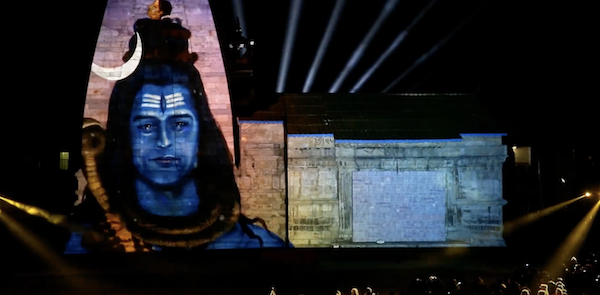
From The Statesman and the Pioneer
New Zealand: Pilots want high-powered laser pointers banned
The April 18 2018 call for prohibition follows two recent reported incidents:
- On April 12 an Air New Zealand plane was hit by a laser strike near Kerikeri Airport at about 6:10 am, just after taking off
- On April 15 there was a laser illumination of a Mount Cook Airline plane flying over the Canterbury town of Rolleston
There were approximately 169 laser/aircraft incidents in 2017, according to the Civil Aviation Authority.
NZALPA news from the New Zealand Herald, details on Kerikeri incident from Stuff Travel, details on Rolleston incident from The Press. Click the “read more” link for additional details in the NZALPA April 18 2018 press release.
Click to read more...
UK: NPAS says only 1.4% of laser perpetrators were prosecuted
James Cunningham told Police Oracle in a March 21 2018 article that there were a number of reasons for the low prosecution rate, including being not being able to follow the laser perpetrator due to being focused on another job (e.g., completing the original mission).
Also, when lasers are pointed from a tower block area, the helicopter crew may not be able to locate the source.
In 2017 there were 67 incidents [not clear if this is NPAS only], compared with 70 in 2016 and 103 in 2015. Cunningham said the reduction is because NPAS is trying to locate and pursue laser perpetrators, and report the incidents as crime. He said the Laser Misuse (Vehicles) Bill being considered in Parliament is a “step in the right” direction that could lead to more prosecutions.
In December 2017, NPAS purchased laser-reducing glasses which can enable pilots to continue even when illuminated by laser light.
From Police Oracle
US: $8 billion space telescope aligned for shipping with $70 hardware store lasers
The container was 100 feet long and had to fit with a clearance of about six inches on each side.
In testing the container’s fit in the C-5C, engineers originally used cameras to line up the container within 1/2 inch of the aircraft centerline. However, the camera method did not work in practice.
So lead project engineer John Andersen suggested using laser guides from a local home repair store. One laser would shine along the centerline of the floor, the other would mark the centerline of the back of the shipping container. As Anderson explained, “So, for about $70, we bought the laser guides, set them up, and we were able to load the container perfectly by following the laser lines.”
He added, “I’m glad we came up with a cheap solution to load the container on the aircraft using the lasers. It didn’t cost thousands of dollars to do it or a lot of time.”
The space telescope is scheduled to be launched from French Guiana in 2019.
From the Dayton Daily News
US: Coast Guard evaluating laser strike protection for cockpit use
The Coast Guard cannot use standard laser eye protection, such as is used in laboratories and industry, because it blocks too much light. One of the options the RDC is looking at is “a flexible optical filter that is reflective of lasers only and has just a slight tint, so it doesn’t interfere with the pilot’s visibility. The material can be applied to any transparent surface, such as the cockpit windshield, to deflect harmful laser beams and prevent them from reaching the inside of the cockpit.”
The chief of the Coast Guard’s Safety Program Management Division indicated eyewear or visors would be short-term solutions, and laser protective coatings for the aircraft would be a long-term solution.
According to Coast Guard information, “[o]nce finalized, the RDC findings will be integrated into an ongoing laser eye protection project the Office of Safety and Environmental Health is conducting in partnership with the Naval Aeromedical Research University in Dayton, Ohio, and the Air Force Research Laboratory at Wright-Patterson Air Force Base in Ohio.”
From a February 21 2018 blog post from the U.S. Coast Guard. Click the “Read more” link for the full blog text. Thanks to George Palikaras for bringing this to our attention.
Click to read more...
Canada: Looking at "all possible options" to fight laser incidents; perhaps a ban and mandatory labels
The statement came after six laser incidents over two days earlier in the month, at Montreal’s Trudeau Airport. Garneau said these made him “very, very mad.”
A Transport official said the options include a ban on importation of powerful lasers, mandatory warning labels, and stronger penalties for those who are caught.
Garneau noted that it is hard to catch a laser perpetrator, making prosecutions “few and far between”. He believes that some people are not aware of the bright-light danger of laser light, but that others “know darn well what they’re doing” and are trying to “provoke something.”
Transport Canada currently has a program called “Not-a-Bright-Idea,” trying to educate the general public about the risks and legal consequences of aiming lasers at aircraft. Since implementing the program in May 2016, laser incident numbers have dropped. There were 590 reported incidents in 2015, 527 in 2016, and 379 in 2017.
Garneau said that despite the 28 percent drop, Transport Canada must do more, and that is why they are exploring other options.
From 660 News and AVweb
Note: In response to a LaserPointerSafety.com request, an email address for interested persons was provided: “Transport Canada is exploring options to reduce laser strikes. Canadians and industry members can provide information to the Civil Aviation Communications Centre by emailing: services@tc.gc.ca”
Germany: Scientific study of laser pointer eye injuries finds 111 cases
Background: Recent years have seen a marked increase in laser-pointer-related injuries, which sometimes involve severe retinal damage and irreversible visual impairment. These injuries are often caused by untested or incorrectly classified devices that are freely available over the Internet.
Methods: We reviewed pertinent publications retrieved by a systematic search in the PubMed and Web of Science databases and present our own series of clinical cases.
Results: We identified 48 publications describing a total of 111 patients in whom both acute and permanent damage due to laser pointers was documented. The spectrum of damage ranged from focal photoreceptor defects to macular foramina and retinal hemorrhages associated with loss of visual acuity and central scotoma. On initial presentation, the best corrected visual acuity (BCVA) was less than 20/40 (Snellen equivalent) in 55% of the affected eyes and 20/20 or better in 9% of the affected eyes. Treatment options after laser-pointer-induced ocular trauma are limited. Macular foramina and extensive hemorrhages can be treated surgically. In our series of 7 cases, we documented impaired visual acuity, central visual field defects, circumscribed and sometimes complex changes of retinal reflectivity, and intraretinal fluid. Over time, visual acuity tended to improve, and scotoma subjectively decreased in size.
Conclusion: Laser pointers can cause persistent retinal damage and visual impairment. In view of the practically unimpeded access to laser pointers (even high-performance ones) over the Internet, society at large now needs to be more aware of the danger posed by these devices, particularly to children and adolescents.
From Birtel J, Harmening WM, Krohne TU, Holz FG, Charbel Issa P, Herrmann P. Retinal injury following laser pointer exposure—a systematic review and case series. Dtsch Arztebl Int, 2017 DOI: 10.3238/arztebl.2017.0831. Original in German, translation in English.
US: High-powered lasers can be obtained from inside a Christmas holiday laser projector
In a January 22 2018 Hackaday post, Tom Nardi purchased a “Home Accents Holiday Multi-Color Light Projector” from a hardware chain on clearance, marked down from $56 to just $14.
He removed the cover with four screws and found the parts inside used connectors instead of solder: “It’s like they wanted us to strip it for parts.”
The lasers were defocused inside. “…[A]t 3 meters the spots looked as large as dinner plates…. Once focused, it becomes pretty clear that these lasers are quite a bit more powerful than the <5 mW listed on the product’s warning sticker.”
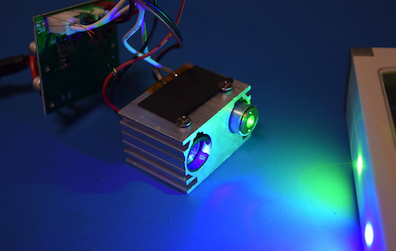
The green and blue laser diode modules inside the holiday projector
Nardi noted that the blue laser, when focused, was “easily able to burn pieces of paper and punch holes in black plastic.” He also estimated that the green laser was “at least twice as bright” as a laser pointer he owns that claims to be 50 mW: “…it certainly would not surprise me if they are both [green and blue] at least 100 mW.”
Nardi writes: “If your biggest take-away from this post is that the Home Depot is selling a 440 nm laser you can use to burn stuff, I certainly don’t blame you.”
From Hackaday. LaserPointerSafety.com has a page with more information, including measurements of the beam output of a Star Shower projector, here.
Commentary from LaserPointerSafety.com: In fairness to Home Accents, the FDA-required warning sticker has to do with the laser power of the unopened unit in its factory configuration. Class 3R (IIIa) laser projectors like this are not allowed in the U.S. to be over 5 mW output power. It may be that after going through the holographic diffraction grating that creates the stars, that the Home Accents projector meets Food and Drug Administration requirements for user access to laser light.
US: MIT develops system to locate laser perpetrators using as few as two cameras, from miles away
The Laser Aircraft Strike Suppression Optical System (LASSOS) uses two or more low-light CCD sensor cameras that observe the night sky, each with a star tracker that determines the attitude of the sensor. The cameras observe a volume of airspace such as around an airport. Beam locations are identified by analyzing the two (or more) different views to find the endpoint of the laser beam.
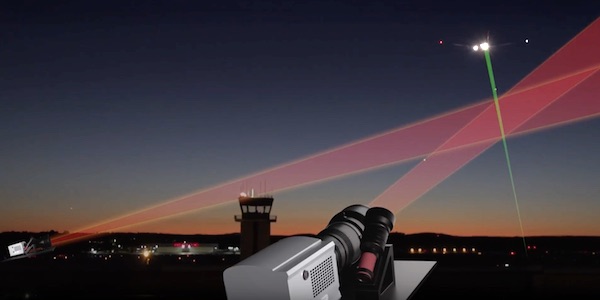
In one test, LASSOS identified the ground location of a laser beam aimed into the sky, using two cameras located nine nautical miles away. The locations was determined within 30 seconds. The system was so accurate that it could differentiate between locations separated by only 5 meters.
A key attribute of LASSOS is that the final output is a Google Earth map with the beam and perpetrator location overlaid. This makes it easy for law enforcement to know the area they will be searching for the perpetrator.
An MIT press release gave no indication of potential installation and operational costs, and did not indicate any further plans for testing or implementation.
LASSOS was developed under Air Force Contract No. FA8721-05-C-0002 and/or FA8702-15-D-0001.
From a September 2017 MIT Lincoln Laboratory press release, reprinted below (click the “read more” link.) MIT also has a YouTube video of the system; the LASSOS description begins about 56 seconds into the video. Thanks to Greg Makhov, who brought this to our attention via a Tech Briefs article printed in January 2018.
US: UPDATED - 6,753 laser/aircraft incidents reported to FAA in 2017; 9% lower than 2016
During 2017, there were 6,753 laser illumination incidents reported to the U.S. Federal Aviation Administration. This compares with 7,442 reports in 2016, and 7,703 reports in 2015. This is a 9% drop compared with 2016, and a 12% drop compared with 2015.
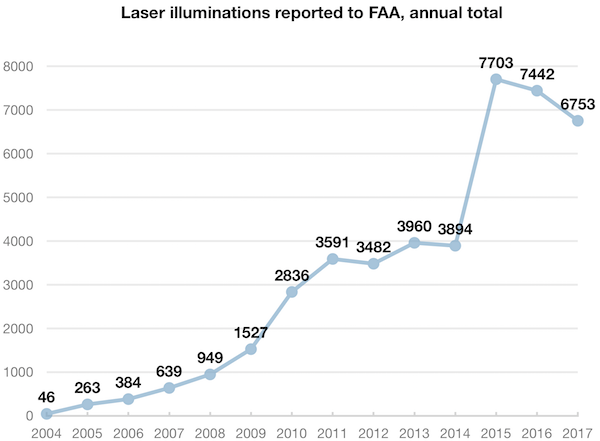
Here is the same data, plotted to show the average number of illuminations per day, during each year:
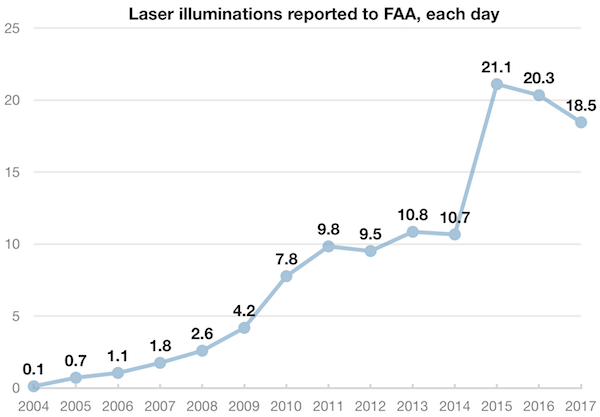
For additional charts and statistics, click the “read more” link.
UK: "Call for evidence" response summarizes many groups' views on laser eye, plane incidents; sets forth actions
The U.K. government published on January 8 2018 a 14-page report on laser pointer safety and potential regulation. The report includes two new actions the government will take to reduce the number and risk of unsafe laser pointers:
1) “strengthening safeguards to stop high-powered lasers entering the country”, and
2) “working with manufacturers and retailers to [voluntarily] improve labeling.
Separately, the U.K. government published the Laser Misuse (Vehicles) Bill on December 20 2017. This makes it illegal to point a laser at vehicles, with a prison term of up to five years and an unlimited fine.
“Laser pointers: call for evidence - government response”
From August 12 to October 6 2017, the Department for Business, Energy and Industrial Strategy opened a “Call for Evidence” consultation. BEIS set forth 19 questions, asking the public to give their views on laser pointer hazards and what actions to take.
The January 8 2018 government response summarizes the 265 responses received.
The report is especially useful because it incorporates the views of many disparate groups: pilots (64% of respondents), “concerned members of the public” (14%), professional laser safety advisors (9%), users of laser pointers (6%), ophthalmologists (6%), and Trading Standards authorities (2%).
The report then distills these views, finding surprising commonality. It is a good overview for the non-expert on two topics:
1) Actual laser pointer hazards — separating fact from fear
2) Potential actions to reduce the number and severity of laser pointer injuries and incidents — including what actions may not work (e.g., licensing).
We have summarized the findings below (click the “read more” link). However, reading the complete document is well worth the time of anyone interested in this issue.
Click to read more...
UK: Laser pen imports to be more restrictive
In addition, “new measures are also being introduced to tackle the sale of unsafe pointers, including more stringent testing.”
The move was supported by the British Air Line Pilots Association (BALPA).
It may help reduce the number of laser pen illuminations of trains (578 incidents were reported between April 2011 and November 2017) and eye injuries (more than 150 reported since 2013, mainly involving children).
Consumer Minister Margot James said the ministry is “going further than ever before” to police the sale of unsafe lasers.
The Argus quoted Professor John O’Hagan, of Public Health England’s laser and optical radiation dosimetry group.He said: “Over time we have become increasingly concerned about the dangers of growing numbers of unlabelled and incorrectly labelled high power laser pointers being bought by the public. It is tragic that we continue to see eye injuries, especially in children. Laser safety experts at Public Health England have worked closely with local authorities in stopping large numbers of these lasers reaching UK consumers. The extra protections proposed should help even further - if you have a laser and you don’t need it, remove the batteries and get rid of it.”
From The Telegraph and The Argus. The stories seem to be a result of the U.K. government publishing, on January 8 2018, a response to their fall 2017 Call for Evidence. The government response included the increased import enforcement actions.
See also the December 2017 news of a new U.K. law that provides stronger penalties for aiming at aircraft. The new import/consumer initiative seems to be part of the government thrust against illegal and overpowered laser pens.
